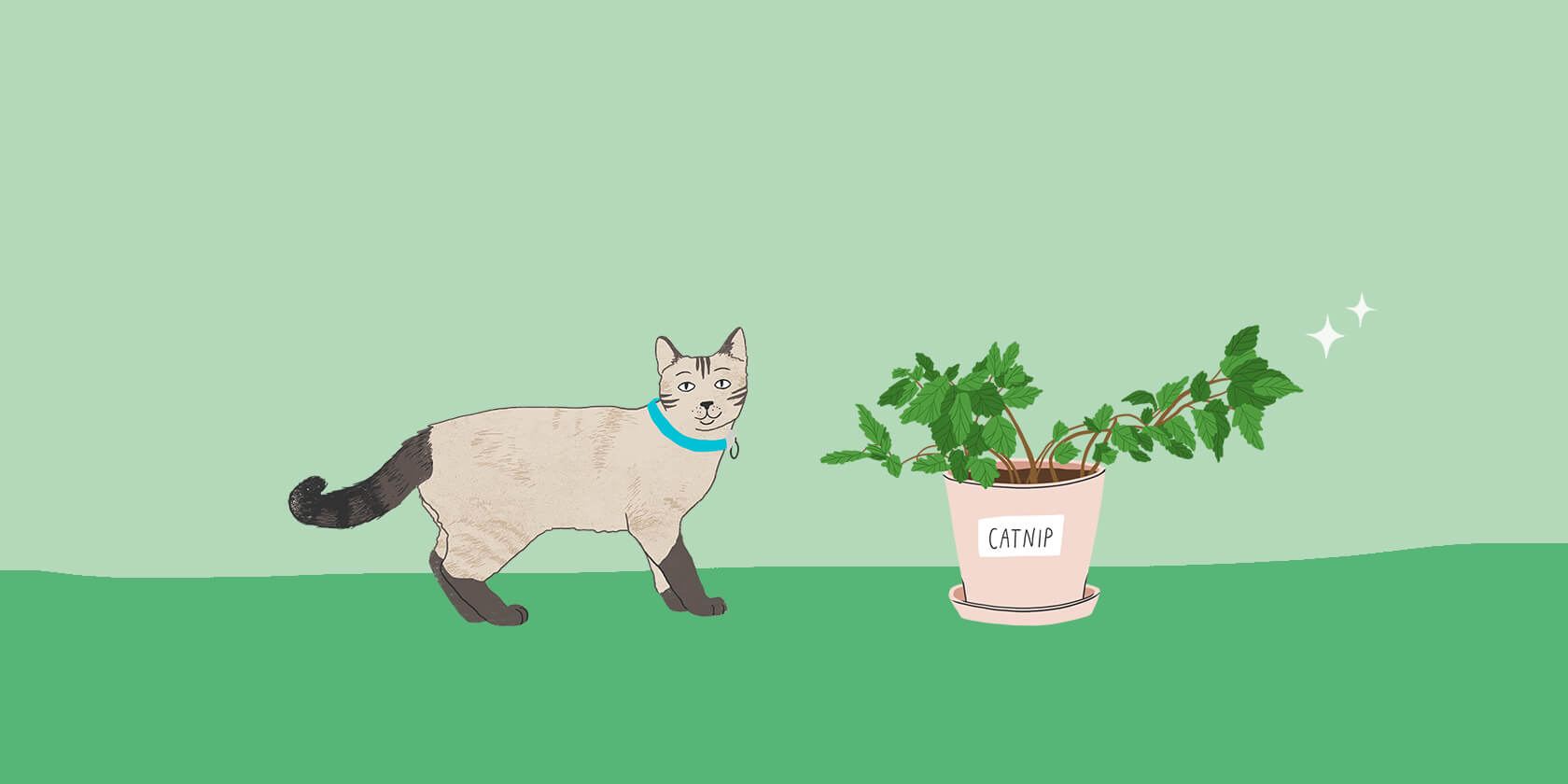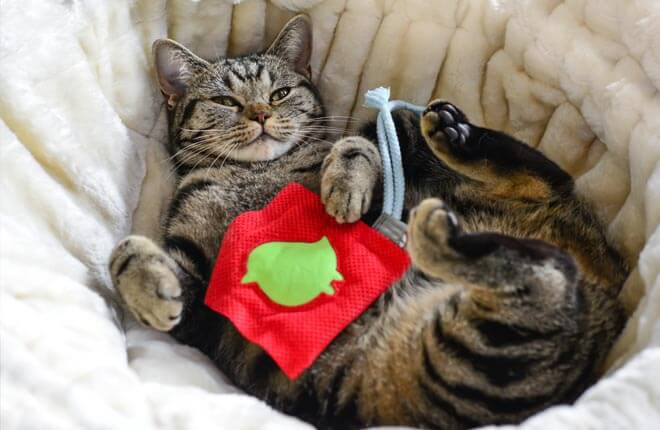Ah, the magic of catnip — it can elicit a state of euphoria in cats. Lazy couch potatoes can be transformed into energetic athletes, jumping and rolling around joyfully. Sprinkling catnip on a toy or scratching post can create interest from even the most disinterested kitty. Some cats take a nosedive directly into their catnip, rubbing it all around their chin and cheeks, while others may express their exhilaration with loud purrs, meows, or even a little bit of drool.
What do you really know about this thing that captivates your cat? Is it safe? How should it be used? Can a cat overdose on catnip? Read on for answers to your burning questions about this fascinating herb.

What Is Catnip?
Its scientific name is Nepeta cataria, a common herb from the mint family. Native to Europe, Asia, and Africa, it now thrives in much of North America. This fragrant plant is easy to grow and popular in herb gardens, but it also springs up as an invasive weed in many locations.
Why Do Cats Like Catnip?
It’s the volatile oil of catnip, specifically the chemical nepetalactone in the oil, that makes this herb irresistible to small and big cats alike. The oil is found in the leaves, stems, and seeds of the catnip plant. Once a cat takes a sniff or two, the chemical enters the cat’s nasal tissue and binds to receptors that stimulate sensory neurons, which in turn provoke a pleasurable response in the brain — and the cat is off to La La Land. It is believed that the sensory response to catnip is similar to what a cat’s brain experiences when smelling another cat’s pheromones.
How Long Do the Effects of Catnip Last?
Catnip bliss is typically short-lived, although intense, lasting about 10 minutes for most cats. Once the pleasure wears off, the cat has a temporary “immunity” to the effects of catnip, anywhere from 30 minutes to two hours.
What Are the Best Forms of Catnip to Use?
Since cats experience the joy of catnip through their nose, the fresher, the better. It’s best to give them a fresh stem and leaves to interact with, or sprinkle and rub the dried, crumbled-up leaves and stems on objects your cat can sniff and enjoy. The fresh form can come from your own garden. You can dry your own or get the dry version through retail stores. Also, cat toys with stuffed dried catnip are easy to find.
Catnip is also available in liquid forms that can be sprayed on objects (never directly on the cat). However, they typically don’t spark as much interest as the fresh or dry forms because they usually don’t contain enough nepetalactone to be appealing.
How Long Does Catnip Last?
Once the leaves and stems are removed, the potency of catnip decreases over time as the volatile oils dissipate. Store what you can’t use, in the freezer in an airtight container, to maintain its potency for as long as possible.
Does Catnip Make a Cat High?
In a way, but it’s different than what we humans think of as being “high.” There are no hallucinations and the cat is aware of their surroundings. There are no known long-term effects on a cat’s brain or other parts of their body.
Is Catnip Bad for Cats?
Catnip is safe for cats. It’s non-toxic and is not addictive. However, if your cat has feline asthma, you should ask your veterinarian if it’s best to stay away from catnip. In some cases, the small particles can make coughing and wheezing worse if inhaled.
It’s important to note, not all cats have the same reaction to catnip. Some can get over-stimulated and may become too hyper or even aggressive for a short time. Others have very little reaction at all. Test a small amount the first time and gauge your cat’s reaction.
Can Kittens Have Catnip?
Although catnip is perfectly safe for kittens, it takes them longer to develop the “catnip response” (usually around six months of age) as they are beginning to reach sexual maturity.
Can Cats Eat Catnip?
Cats can eat catnip, in most cases, without harm. However, just like most good things in life, everything in moderation. It’s possible that excessive amounts of catnip may cause some gastrointestinal upset for your cat. So, as a precaution, limit this treat to around once a week. It’s also not recommended to routinely add to your cat’s food.
Can Cats Overdose on Catnip?
Cats cannot overdose by smelling or contact with catnip. If eaten in large quantities, cats can develop diarrhea and vomiting. Also, cats get used to catnip quickly (similar to building a tolerance). If you give it too often, it will lose its effect.
How to Use Catnip
Fun is one of the main reasons people give their cats catnip — not only for the cat but their people too! The entertainment value can be huge as your cat sprints around and performs flips and rolls.
This enticing herb can also be a powerful training aid, providing a compelling reward for doing things right. To encourage your cat to claw a scratching post instead of your furniture, rub some catnip on the scratching post to make it more appealing. Sprinkle a little catnip on a cat tree or cat bed to create a positive association and encourage your cat to use them.
Does your cat need a little inspiration in the exercise department? Enhancing toys, bubbles, and paper bags crushed into a tight ball with catnip may be all that is needed to put some spring in your cat’s step.
Also, stimulation of the sense of smell is another way to add environmental enrichment to your kitty’s life.
Finally, for stressed and anxious cats, catnip can provide a few minutes of relief. It helps create a moment where they can relax and lose their inhibitions, which can have a big impact on their overall mental health.
Why Does One of My Cats Go Crazy with Catnip, But It Doesn’t Seem to Have Any Effect on The Other?
A study conducted in 2017 confirmed previous studies finding that 32% of domestic cats do not respond to catnip — meaning 68% do[1]. The reason for this is believed to be genetic. Not to worry, though, the non-responders aren’t aware of this limitation and won’t feel like they are missing out. You can be grateful that you get at least one catnip-induced show in your house!
ZPC-01349R1
- Bol S, Anderson-Shelton GD, Buckingham L, et al. Responsiveness of cats (Felidae) to silver vine (Actinidia polygama), Tatarian honeysuckle (Lonicera tatarica), valerian (Valeriana officinalis) and catnip (Nepeta cataria). BMC veterinary research. 2017;13(1):70.



